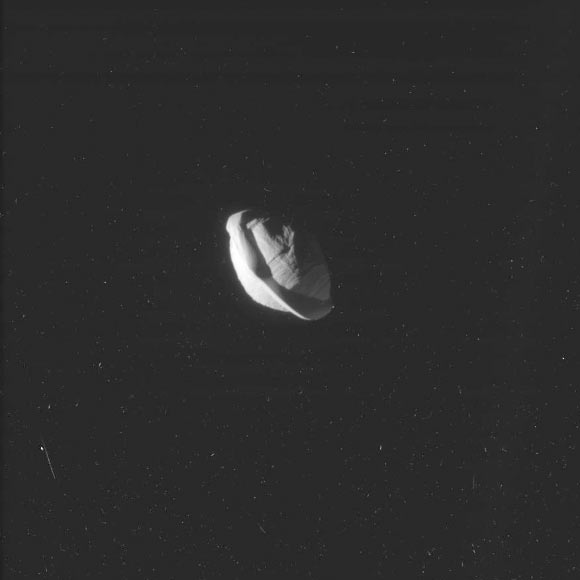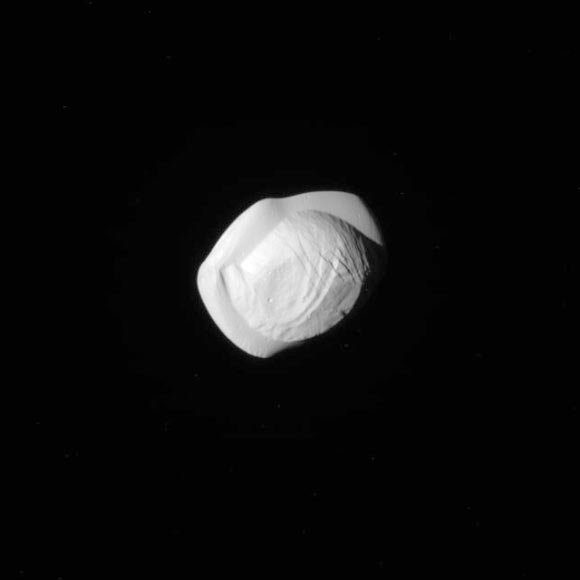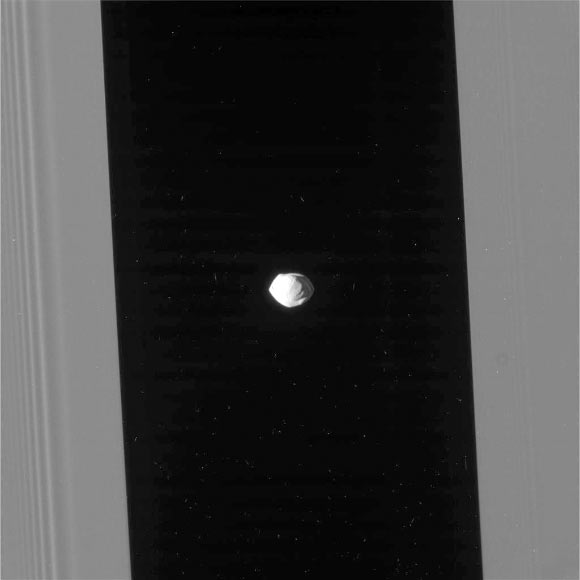NASA’s Cassini spacecraft captured these stunning images of Pan, the second-innermost moon of Saturn, during a close flyby on March 7, 2017. These images are the closest images ever taken of the flying saucer-shaped moon.

This image of Saturn’s small moon Pan was taken during the close flyby of NASA’s Cassini spacecraft on March 7, 2017, received on Earth March 8. The flyby had a close-approach distance of 15,268 miles (24,572 km). Cassini’s camera was pointing toward Pan, and the image was taken using the CL1 and CL2 filters. Image credit: NASA / JPL-Caltech / Space Science Institute.
Pan was discovered by SETI Institute researcher Dr. Mark Showalter in 1990 using images taken by NASA’s Voyager 2 spacecraft nine years earlier.
Also designated Saturn XVIII, Pan is a small moon with a mean radius of 8.8 miles (14.1 km) and dimensions of 10.7 x 9.8 x 6.5 miles (17.2 x 15.7 x 10.4 km, respectively).
It has a prominent equatorial ridge that gives it a distinctive flying saucer shape.

This image of Pan was taken during the close flyby of Cassini on March 7, 2017, received on Earth March 8. The flyby had a close-approach distance of 15,268 miles (24,572 km). Cassini’s camera was pointing toward Pan, and the image was taken using the CL1 and GRN filters. Image credit: NASA / JPL-Caltech / Space Science Institute.
According to planetary researchers, Pan was likely formed at the same time as the giant planet’s distinctive rings.
This tiny moon orbits Saturn once every 13.8 hours at an average distance of 83,000 miles (134,000 km), within the Encke Gap, a 200 mile (325 km) opening in Saturn’s A ring.

This image of Pan was taken during the close flyby of Cassini on March 7, 2017, received on Earth March 8. The flyby had a close-approach distance of 15,268 miles (24,572 km). Cassini’s camera was pointing toward Pan, and the image was taken using the CL1 and CL2 filters. Image credit: NASA / JPL-Caltech / Space Science Institute.
Pan and small moons like it have profound effects on the rings.
The tiny moon acts as a shepherd moon and is responsible for keeping the Encke Gap open.
It creates stripes, called ‘wakes,’ in the ring material on either side of it.
Since ring particles closer to Saturn than Pan move faster in their orbits, these particles pass the moon and receive a gravitational ‘kick’ from Pan as they do.
This kick causes waves to develop in the gap and also throughout the ring, extending hundreds of miles into the rings.
These waves intersect downstream to create the wakes, places where ring material has bunched up in an orderly manner thanks to Pan’s gravitational kick.







